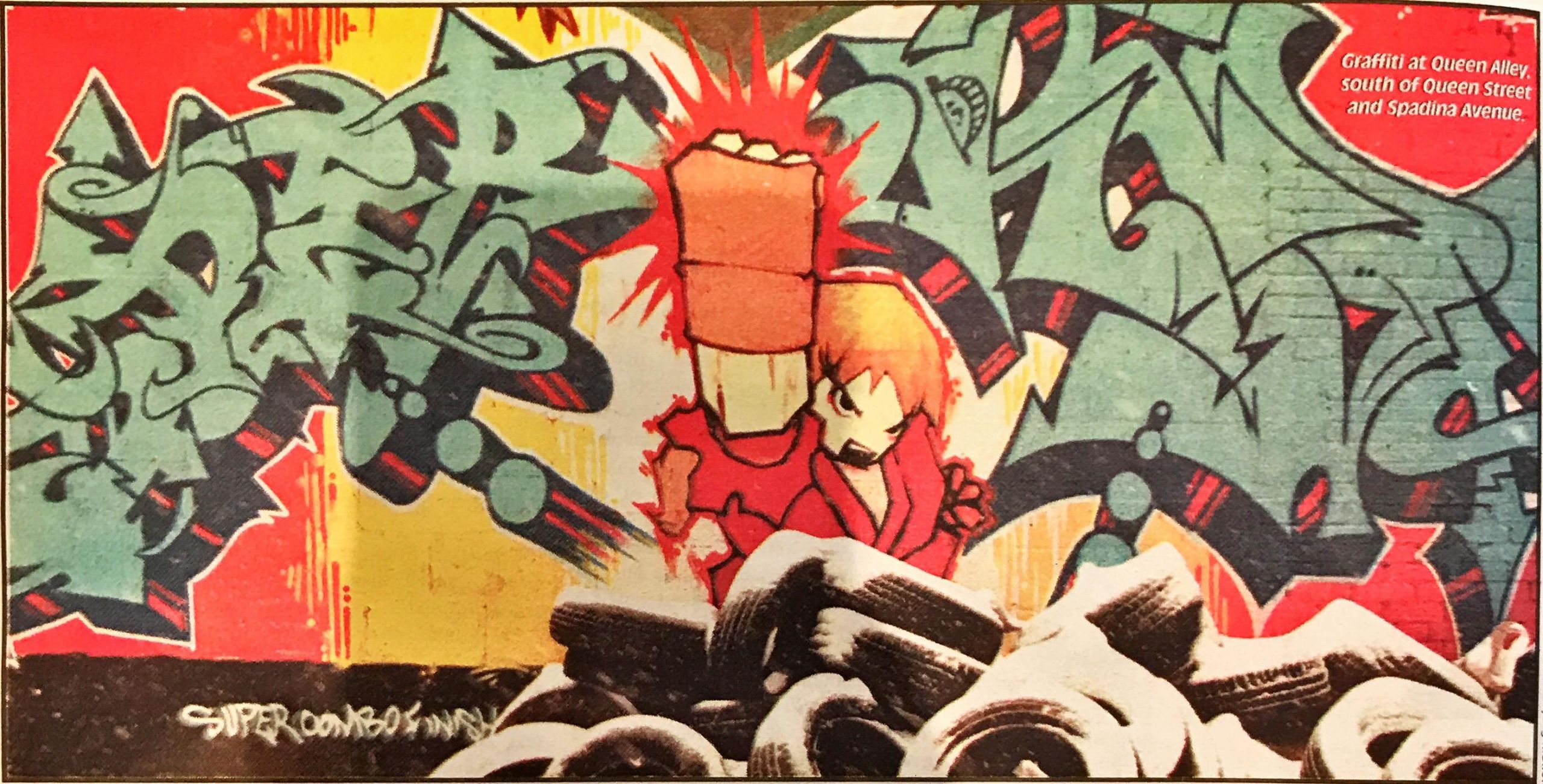By Jessie Stones
A broken fence is her only way into the Keele Junction freight yard, her path around the empty train cars illuminated by the moonlight. Spray paint cans clink together as she pulls her backpack from her shoulders in front of the car she’s chosen.
For months she’s worked on the piece in her sketchbook, manipulating characters and letters until they’re perfect. Now it’s bombing time.
She takes various nozzles out of her pocket and fits them on her cans of blue, green and yellow paint. This is art under pressure, and every second counts until she has to run from security or the cops.
She takes the chance because she loves graffiti. But there are a few of her in Toronto.
There’s a shortage of female writers—in graffiti lingo, people who write their signatures with markers or spray paint. And there are even fewer women who bomb or piece—paint an entire “masterpiece” on walls or freight trains.
Most young women wouldn’t dare risk getting caught with a can of spray paint in their hands. For those adventure-seekers who are up for the thrill, this is art, not vandalism.
Of the few female graffiti artists tagging or bombing in Toronto, Bomba is the most prominent. Most of her peers are male.
“I can count on one hand the girls who actually bomb,” says the dynamic 30-year-old, her long dark, blonde-streaked hair topped by a baseball cap with the name of her homeland, Chile, stitched on the front.
“I would love to go piecing with an all-female crew. There’s a different energy with women.”
The daughter of a Chilean political prisoner, Bomba was exposed to politically motivated art as a child, and her parents encouraged her to explore her creativity.
“The first mural I painted was this huge portrait of Che Guevara at a street festival,” she says. “I was 10 years old.”
She came to Toronto in 1975, and 10 years began tagging under the name Raw. In 1990, she took the moniker Bomba, which means “to bomb” in Spanish.
Bomba was the driving force behind one of the city’s first graffiti transformation programs, giving young people the chance to paint the walls of business in their community. Until recently she worked at Horizons for Youth, a rehabilitation program for juvenile offenders.
“I painted a lot of legal walls with those kids,” she says. “It’s a very powerful feeling to see them so proud of something they’ve created.”
One night last summer, Bomba confronted a cocky teenager from Vancouver on the football field at Central Technical Secondary School. They were surrounded by a well-organized army of adolescent males ready to defend Bomb, den mother of sorts to Toronto’s young hip hop community.
The visitor was offended by one of Bomba’s pieces, “Women a’Runt’ings” (women are running things, after the all-female reggae band she used to play bass with), so he painted small characters over some of her masterpieces—a big insult for a graffiti artist.
“Because I was a female he felt he had the right to challenge me,” she says with a smirk.
But her boyds, weren’t about to let their mentor suffer any indignity. “They hid and followed me when I went to meet the guy,” she says with a laugh over a glass of red wine at a College Street cafe. “I told [the Vancouver artist], ‘It’s a good thing you didn’t try that shit in New York, buddy, or you’d be dead now.’”
Graffiti has evolved into something a little more refined and a lot more mainstream since the mid-1960’s, when it was used to make political statements or mark street gangs’ territories.
Today’s nearly every mailbox and garbage can is tagged, and pieces are plastered all over alleys and legal walls. Even major corporations such as Sony are contracting graffiti artists to update their marketing images.
In the early days, female artists such as New Yorker Lady Pink held their own against their male counterparts. Pink started painting in the early 1980s and her work has since been displayed in art galleries across Europe and America. She still bombs freights and is considered almost an icon in the graffiti world.”That girl is like a rock star,” Bomba says.
No female painter in Toronto can compare.
Eve, an aspiring 20-year-old graffiti artist, recently made a list of all the other women tagging or painting in the city. “There are, like, 12,” she says on the phone from her downtown loft.
Last summer, she and a few friends formed Dew, an all-girl graffiti crew, to make up for the lack of female representation.
Eve says in her experience, girls are only exposed to graffiti through their boyfriends. She tagged along with her boyfriend of two years while he bombed, and when they broke up she started writing on her own.
“I missed [graffiti] when I moved out. One day I just stopped and through, ‘I can do it myself,’” she says. “I couldn’t believe I hadn’t started before. Graf is so addictive.”
It’s also considered a guy’s club.
“Maybe girls just aren’t as daring as boys,” write Tacobelle, a female painter in Sydney, Australia, in an E-mail. “In Australia, the penalties are severe. Like, you can go to jail.”
Painting anywhere has its consequences. Task, a male graphic designer who does graffiti, was recently fined and sentenced to 300 hours of community service.
“I was caught vandalizing private property,” says the 27-year-old. “I just wasn’t fast enough.”
Bomba paints under a different name now to protect her identity from those who don’t appreciate her work. She continues, because she considers it art, not vandalism.
“Graf is so reflective of the environment we live in—graphic, toxic,” Bomb says. “I don’t think that if you actually understand the importance of what you’re doing, it can be considered vandalism.”
She pauses and smiles. “The way I see it, graffiti is the art of democracy.”











Leave a Reply